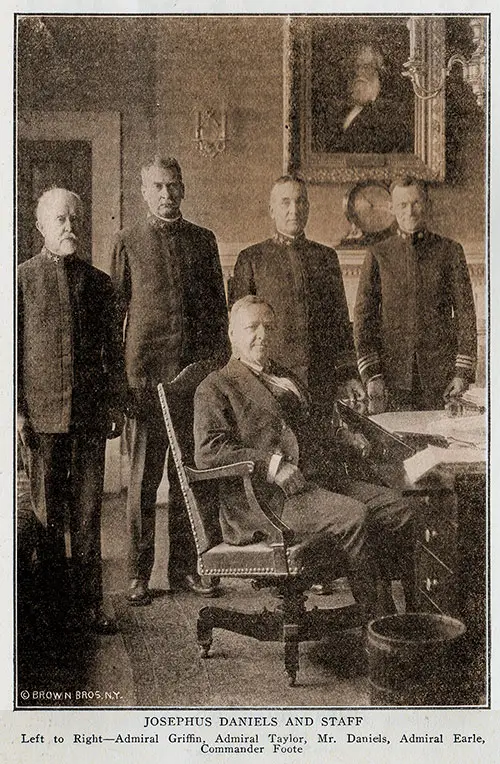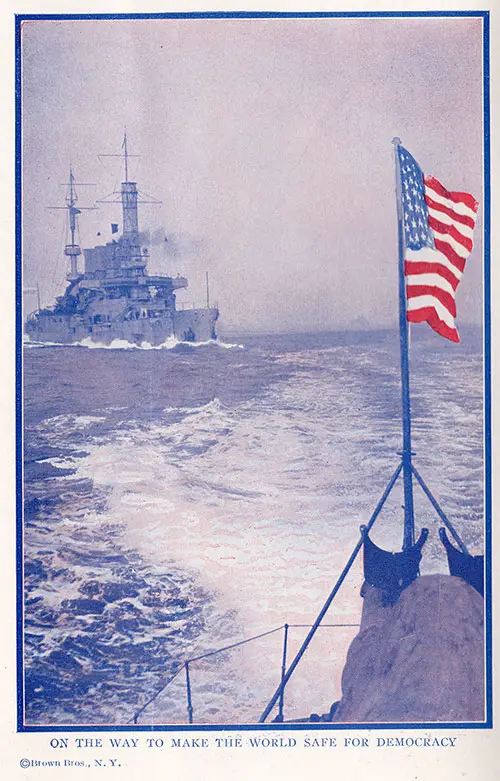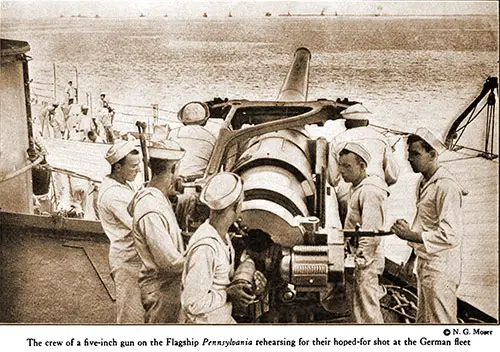US Navy - Our First Line of Defense - 1919

Josephus Daniels and Staff. Left to Right—Admiral Griffin, Admiral Taylor, Mr. Daniels, Admiral Earle, Commander Foote. Photograph © Brown & Bros. NY. Our Navy's Part in the Great War, 1919. GGA Image ID # 19781a014c
OUR "FIRST LINE OF DEFENSE"
BY JOSEPHUS DANIELS, Secretary of the Navy
The more the American people know about their Navy and its achievements, the greater will be their pride and confidence in it. Our war experiences have convinced me that the Navy can accomplish any task it may undertake and that it is ready and willing to undertake almost anything that needs to be done.
In the war, the Navy was called upon to undertake many novel and untried tasks, but whenever any new and difficult duty was imposed, the entire service, from admirals to apprentice seamen, responded with enthusiasm and went at it with the initiative and energy which compelled success.
When we were called upon to arm American merchant vessels, hundreds of expert gunners were required and many more guns than seemed possible to secure, of the calibers necessary. But we got the guns and the gunners, and it was not long before practically all American vessels sailing the war zone were armed and carried naval gun-crews.

The US Navy Is on the Way to Make the World Safe for Democracy. Photograph © Brown Bros. NY. Our Navy's Part in the Great War, 1919. GGA Image ID # 180c375366
When the war was declared, we possessed few of the auxiliary vessels required for scouting, patrol, and other duties, but they were secured. We needed five times as many anti-submarine craft, and we built submarine chasers and destroyers by the hundred.
There were few transports available when the Navy was entrusted with the transportation of American troops to France, but, from small beginnings, the Cruiser and Transport Force was built up into a huge fleet.
Two million American troops were safely transported to France, with large assistance from the British. Such aid as the French and Italians could furnish; about 950,000 of these were carried over in American vessels.
The manning and operation of troop-ships and cargo transports by the Navy required hundreds of crews. These were ready when required, and hundreds of thousands of soldiers and millions of tons of munitions and supplies were transported in vessels manned by the Navy. These joint operations of Army and Navy were conducted in the closest co-operation, and their success reflects the highest credit on both. In this war, it has been, in fact, as well as in name, a "United Service."

The Crew of a 5-Inch Gun on the Flagship USS Pennsylvania Rehearsing for their Hoped-For Shot at the German Fleet. Photograph © N. G. Moser. The United States in the Great War, 1919. GGA Image ID # 180d5231e1
One of the most gratifying features of the war has been the close co-operation of the Allied navies. From the time Admiral Sims arrived in London, there has been the most complete accord. Unity of purpose and command have been practically in effect from the start.
Our destroyers, submarines, sub-chasers, and other craft have served with, and at times under the command of, the British, French and Italian officers; our battleships for a year constituted a regular division of the British Grand Fleet; our forces on the coast of France worked as smoothly as if the French and American navies had been one.
We had the same intimate relations with the Italians in the Mediterranean and the Adriatic, and the Japanese in oriental waters. Our relations with our Latin-American neighbors were never so close and cordial as during the past two years.
We were privileged, with the co-operation of the British, to construct the North Sea Mine Barrage, and were associated with them in laying the oil pipeline across Scotland and in other enterprises of magnitude, and we were privileged to aid the French in the patrol of their coast and the improvement of the ports assigned for the landing of American troops and to assist the Italians in some of their brilliant and successful enterprises.
With their huge 14-inch guns, the Naval Railway Batteries rendered valiant service on the Western Front in the war's closing days. It is a matter of pride that the Marines were privileged to serve with that great American Expeditionary Force under General Pershing, which played such a material part in the Germans' final defeat.
Our Navy's growth to more than half a million officers and men, manning two thousand vessels, has been almost phenomenal; but no less so than the spirit and efficiency these men have displayed, their courage and enterprise in facing every danger and performing every duty imposed upon them.
There has been no more striking instance of a sea power than in this war, in which the Allies held control of the seas and, despite ruthless submarine warfare and the activity of raiders, at last, compelled the surrender of the German High Seas Fleet. It is gratifying that our own. The Navy had a part in accomplishing this result; that it has played an important role in the greatest of wars and written a new and brilliant page in history.
Stronger, larger, more powerful, and efficient than ever before, the Greater Navy is prepared to render greater service to the American people and preserve the peace of the world.
Washington, D. C., March 6, 1919.
Josephus Daniels, "Our 'First Line of Defense,'" in Our Navy's Part in the Great War, New York: John H. Eggers Company, Inc., 1919, pp. 2-4.
